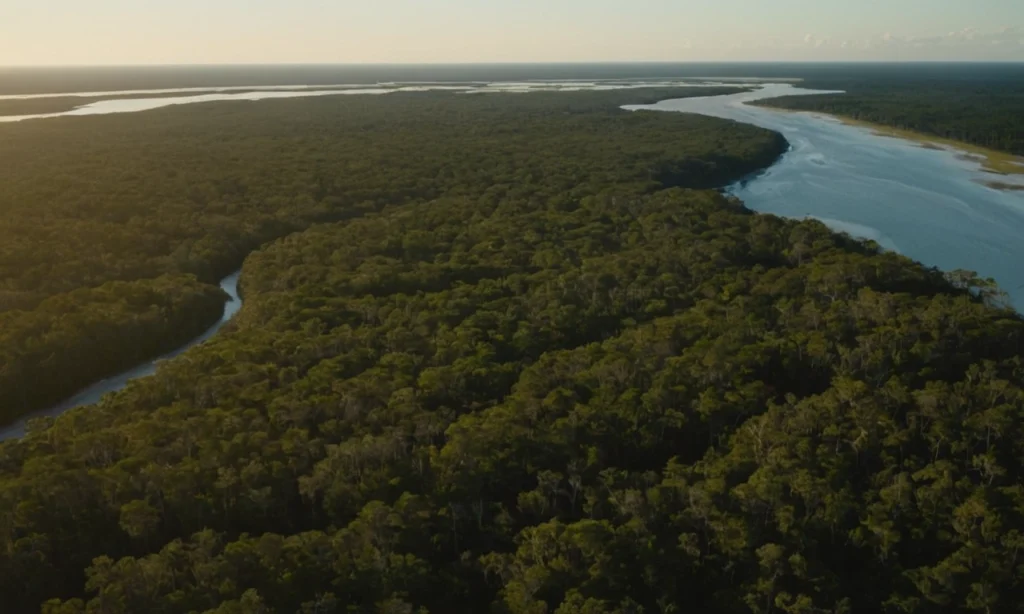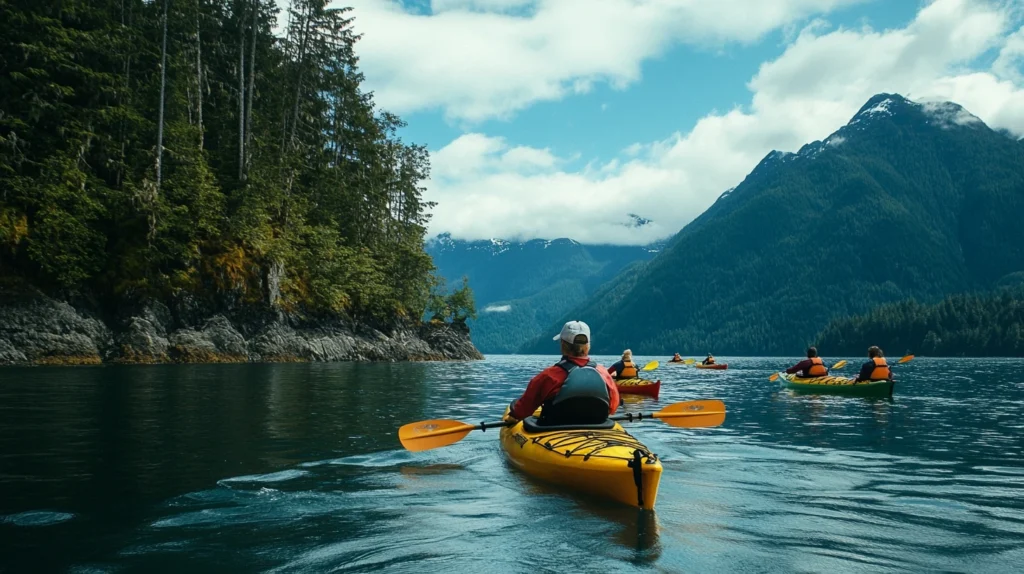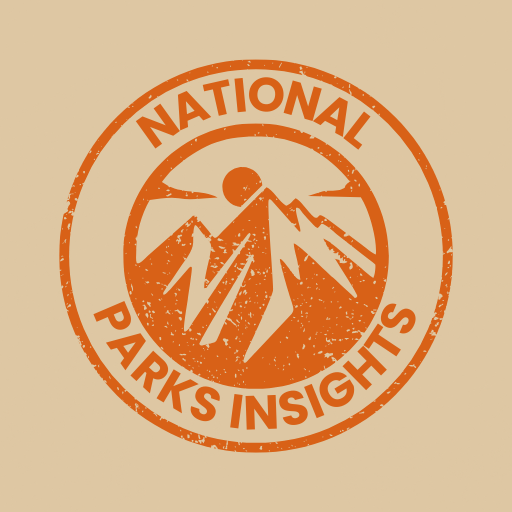Discovering Cumberland Island National Seashore Georgia

Hold onto your sunhat ’cause we’re setting sail for Georgia’s own gem – Cumberland Island National Seashore. It’s like stepping into a time capsule of nature and history. This spot’s been protected since October 23, 1972, covering over 36,347 acres to show off one of the Atlantic Coast’s finest barrier island get-ups.
Unique Ecosystem of Cumberland Island
Dive headfirst into the wild wonders of Cumberland Island and get ready to meet Mother Nature at her best. The island rolls out three major ecosystem zones, each boasting its own cool natural features and critters.
- Salt Marshes
Picture this: the western island stretches out with salt marshes full of life. It’s a squishy, bustling carnival for birds, fish, and invertebrates. These marshes are padded with smooth cord grasses, holding the island together against erosion and storm troubles, while trying to dodge hungry feral horses.
- Maritime Forest
Take a step inland where the maritime forest welcomes you with open branches. It’s a dense tangle of gnarled oaks, draped in hauntingly lovely Spanish moss, and palmetto plants making up the floor. This magical woodland is home to a circus of critters: white-tailed deer, squirrels, raccoons, nine-banded armadillos, and alligators living life (Wikipedia). Wander through, and let the forest cast its dappled spell on you.
- Beach and Dunes
Now, let’s hit that iconic 17-mile stretch of sandy dreams. The eastern shore flaunts sandy shores and rolling dunes, just begging you to kick back and relax. It’s a prime hangout for beach bums and nesting sea turtles, not to mention it’s a chill zone for shorebirds taking it easy.
| Ecosystem Region | Key Features | Notable Wildlife |
|---|---|---|
| Salt Marshes | Smooth cord grasses, tidal creeks | Birds, fish, invertebrates |
| Maritime Forest | Live oaks with Spanish moss, palmettos | Deer, squirrels, raccoons, armadillos, alligators |
| Beach and Dunes | Sandy shores, rolling dunes | Sea turtles, shorebirds |
This island has around 8,840 acres of designated wilderness, the biggest for any east coast barrier island in the USA (National Park Service). It’s where wild stays wild, giving you more than a peek at nature’s good side.
While you’re out and about, watch for the legendary feral horses. They stride freely over the island, painting the scene with a touch of untamed beauty. Just remember, these horses love munching on the greenery, especially in those high marsh areas.
Swing by Cumberland Island for a true taste of its natural treasures. Whether you’re poking around the salt marshes, meandering through the maritime woods, or soaking up the beach vibes, the island offers up a buffet of awe-inspiring sights sure to tickle your adventure bone. Got a craving for more national parks near Georgia? There’s plenty more where that came from!
Experiences on the Island

Get ready to dive into a treasure trove of adventures at Cumberland Island National Seashore in Georgia! Whether you fancy yourself a master fisherman, a camping pro, or just someone who gets giddy at the sight of trees, this place has got your name on it.
Angling and Fishing
Got a rod? Want some fish? You’re in the right spot! Cumberland Island’s got fishing spots that would make even the fish excited to be caught. Streams, lakes, tidal marshes, or just chilling by the beach—take your pick and start casting. You might land yourself a red drum, flounder, or even a sea trout. But hey, check out the rules and grab those permits or the fish might just laugh at you from a distance.
Camping Adventures
If sleeping under the stars is your idea of fun (or if you just want to scare yourself silly with ghost stories), Cumberland Island’s got your back. Hop online to Recreation.gov and snag a spot before they’re all gone. Whether you like your showers cold at Sea Camp Campground or want to go full caveman at Stafford Beach’s no-frills zone, there’s a space for you.
| Campground | What’s There | Book Ahead? |
|---|---|---|
| Sea Camp | Restrooms, showers (brrr!) | Yep |
| Stafford Beach | Just you and nature, no frills | Yep |
| Wilderness Sites | Off-grid adventures | Yep |
Exploring Nature Trails
When it comes to trails, Cumberland Island’s bringing the A-game. You don’t have to be a marathon hiker to enjoy these paths; there’s something for every pair of feet. Easy, breezy strolls on the River and Parallel Trails, or push your limits on the Southend Loop—it’s all right there (NPS.gov). Each route is like a secret handshake with the island’s wild side.
Some trails to check out:
- River Trail: Super simple. Get cozy with the riverside views.
- Parallel Trail: A bit more effort, lots more scenic goodness.
- Southend Loop: For the bold, this one will flex those calves through a mix of beaches and woods.
Hit up Georgia’s national parks for some more outdoor goodness, or spy on the alligators at Okefenokee Swamp Georgia. Remember, keep it clean out there and make sure the only thing you’re leaving behind are footprints.
Is a trip to Cumberland Island on the horizon? Check out Georgia State Parks Map for the lay of the land and peek at Georgia National Parks Camping for the best sleep-under-the-stars spots. Cumberland Island is more than ready to greet you, so pack those bags and let the adventure roll!
Recreational Activities

Dive into a fun mix of play and leisure at Cumberland Island National Seashore Georgia and get lost in all that Mother Nature has to offer. There’s plenty to get your adrenaline pumping or soothe your soul—whichever floats your boat.
Boating and Kayaking
Float your boat! Or paddle, if that’s more your speed, around Cumberland Island’s peaceful waters. Whether you’re steering your own vessel or gracefully paddling a kayak, make sure you’re packed and ready for a day out on the water. Here’s a peek at what you might try:
| Activity | Description | Prep |
|---|---|---|
| Private Boating | Swoosh through the island’s creeks and winding marshes. | Don’t set sail without your safety gear. |
| Kayaking | Take a peaceful paddle, scanning the shore for sights. | Map the route and pack water, friends. |
Photography Opportunities
Snap to it! The diverse beauty of Cumberland Island offers plenty of photo ops. Capture beaches, forests, marshes alive with critters, plus some historic nuggets for good measure. Here are some scenes to snap that can’t-miss pic:
- Sunrise or sunset blazing over untouched beaches.
- Lush greens of maritime forests filled with wildlife.
- Ancient vibes from places like the Dungeness Ruins.
Biking and Beach Activities
Ready to pedal? Let’s hit the trails! Get on your bike and explore Cumberland Island’s scenic routes, then cool off in the ocean or hunt for seashells (NPS). With its mix of terrains, biking here gives you a sense of adventure no matter your age.
| Activity | Spot | Tips |
|---|---|---|
| Biking | Trails galore! | Bring a lock and helmet for your trusty steed. |
| Beachcombing | Sandy expanses calling your name. | Spot special shells and maybe some ocean creatures. |
| Swimming | Safe beach zones. | Keep an eye on the tide, folks! |
Cumberland Island’s got a treasure trove of memory-makers waiting for you. Whether you’re cruising the waters, snapping away, or cycling through the scenery, this place promises more than just a casual day trip. For a lowdown on more Georgia wonders, check out our scoop on the best national parks in Georgia and other national parks near Georgia. Time to get out there and explore!
Cultural and Historical Insights

Cumberland Island National Seashore in Georgia is like a time machine with beaches. It’s a place where past and present collide, offering curious travelers a peek into its lively history, from ancient times to when it became the cherished national seashore it is today.
Archeological Heritage
This island is a real archaeological goldmine with over 4,000 years of human history waiting to be discovered. Imagine setting foot where Native Americans thrived, Spanish missions once stood tall, and colonial fortresses dotted the landscape. It’s like reading a history book but way cooler because you’re right there exploring it. As you wander around, you’ll stumble upon remnants of these old cultures, giving you a window into their daily lives. If you want to map your next adventure, check out our Georgia State Parks Map.
Plantation Era History
Cumberland Island was a beehive of activity during the plantation era. Indigenous people roamed the land long before it became a prized part of Spanish Florida in the 16th and 17th centuries. Then the English came swooping in, trading for control after making a treaty with the Creek nation. The island turned into a bustling agricultural hub; picture fields of Sea Island cotton, rows and rows of indigo, and swaying rice plants.
| Time Period | Key Events |
|---|---|
| Pre-1600s | Native American settlements |
| 16th-17th Century | Spanish Florida territory |
| 1763 | England takes over post-treaty with Creek nation |
| 18th-19th Century | Plantation boom with cotton and indigo |
Curious about more plantation stories? Don’t miss our take on the Best National Parks in Georgia.
National Seashore Establishment
Fast forward to October 23, 1972 – a game-changing day when Cumberland Island earned its stripes as a National Seashore, thanks to President Richard Nixon’s signature. The Carnegie family and the Mellon Foundation teamed up to sell it to the federal government, ensuring its future in the National Park Service (Wikipedia).
Mid-century rolls around and the Department of the Interior has its eyes on Cumberland Island, highlighting it as a rare example of big-scale maritime conservation left on the Eastern Seaboard (Georgia Conservancy). This success story means visitors today can enjoy not just the stunning vistas but also the island’s spellbinding historical tale. Discover more about the incredible national parks close by in our article National Parks Near Georgia.
Want the lowdown on all of Georgia’s national treasures? Dive into our Georgia National Parks List for more historical gems.
Wildlife Encounters

Feral Horses
On Cumberland Island in Georgia, you’ll bump into a bunch of wild horses that are pretty much the rock stars of the place. These horses, a mix of all kinds of breeds, have called this island home for ages (National Park Service).
But heads up—their munching habits have put quite a strain on the island’s natural world. They love to chow down on smooth cord grasses, and that’s not exactly a good thing. It’s messing up the marsh area’s vibe, causing the land to erode faster and making it tougher to handle storms. Plus, their grazing is putting a dent in the fiddler crab population, which is bad news for the salt marsh scene (Wild Cumberland).
| What’s Happening | What’s the Deal With It |
|---|---|
| Grazing Adventures | They’ve got a thing for cord grass |
| Wild Life Challenge | Fewer fiddler crabs hanging out |
| Earth Trouble | More erosion, less room for storms |
Native Animals
Cumberland Island’s like a zoo without the cages where you’ll cross paths with everything from munching white-tailed deer and cheeky raccoons to nine-banded armadillos, wild boars, feral hogs, and swampy American alligators. This critter collection makes the island a giant, furry playground that nature lovers can’t resist checking out.
| Creature Crowd | A Little Bit About Them |
|---|---|
| White-tailed Deer | Grass-loving grazers |
| Squirrels | Forever on the move |
| Raccoons | Campsite crashers |
| Nine-banded Armadillos | Armored little tanks |
| Wild Boars | Forest wanderers |
| American Alligators | Marshy stalkers |
And if you’re into hunting, you’re in luck. They have hunts on the island every year to keep things in check. You’ll find the dates and how to sign up on the NPS website.
Natural Habitats
The island flaunts three primary hangouts for all its animal pals, each a bit of a paradise for the critters around.
- Salt Marshes: Stretching along the west coast, these are buzzing with aquatic life and plants that keep the area thriving.
- Maritime Forest: It’s an enchanted forest with twisted live oaks decked out in Spanish moss and palmettos, offering food and shelter for loads of native animals.
- Beach and Dunes: The sweeping 17-mile stretch is where shorebirds nest, and the dunes are bustling with coastal life.
With this mix of ecosystems, Cumberland Island is a true gem worth saving, earning it applause from the Department of the Interior as a lighthouse of maritime conservation. For more adventures in Georgia’s green spots, you might wanna peek at our guide on best national parks in Georgia.
Island Management Challenges
Keeping Cumberland Island National Seashore, Georgia its that charming and ecologically intact is no walk in the park! You’ve got to nail down a few knotty problems to keep this gem shining for tomorrow’s wanders.
Population Control Efforts
Let’s chat about feral critters—they’re no small fry on Cumberland Island. Those wild horses and hogs are chomping through more grass than my Uncle Bob at a backyard barbecue! Their munching is wearing down the high marsh areas, and not in a good way. This overgrazing is like an open-invite for bigger baddies: erosion and storm havoc. Why? Well, these critters are messing with the marsh’s superpower to trap sediment, which is what fiddler crabs need to throw their parties. Now, our salt marshes are left with a “Closed for Business” sign!
The folks at the National Park Service are playing referee here, juggling laws and public input like it’s an Olympic sport. They’re cooking up plans to tame these feral friends in their upcoming Resource and Wilderness Management Plans.
Erosion and Environmental Impact
Erosion—it’s like the island’s way of shaving too close for comfort. We’ve got rising seas and climate changes rolling dice with the tides, and let’s not overlook hurricanes Matthew, Irma, and Dorian, which walloped the place between 2016 and 2019. It’s like they rented out the island for a wave-smashing party (Savannah Now).
Brace yourselves: a study forecasts that the western coast of the island could be nibbled away by daily tides, with the erosion line sneaking a whole 120 feet inland by the time we hit the year 2100 (Savannah Now).
Future Preservation Strategies
Eyeing the horizon, it’s clear that preserving Cumberland Island needs a mix of science, sustainability, and simple good sense. The National Park Service is cooking up plans that aim to care for Mother Nature with a little TLC—taming those wild animals and facing erosion head-on. They’re all about getting the scoop on climate changes and and how to tackle those rogue weather patterns.
They’re teaming up with experts and locals to spread the word on sustainability. Call it the buddy system for preservation. Why not rope in visitors too, so everyone lends a hand in keeping things spick and span? By pulling out all stops, we can save this island’s charm and keep it blossoming for the next gang of nature lovers.
You can check out more about the Peach State’s finest parks in our best national parks in Georgia guide. Or, sashay over to the georgia national parks list. If smelly swamps float your boat, dip into the okefenokee swamp georgia.




